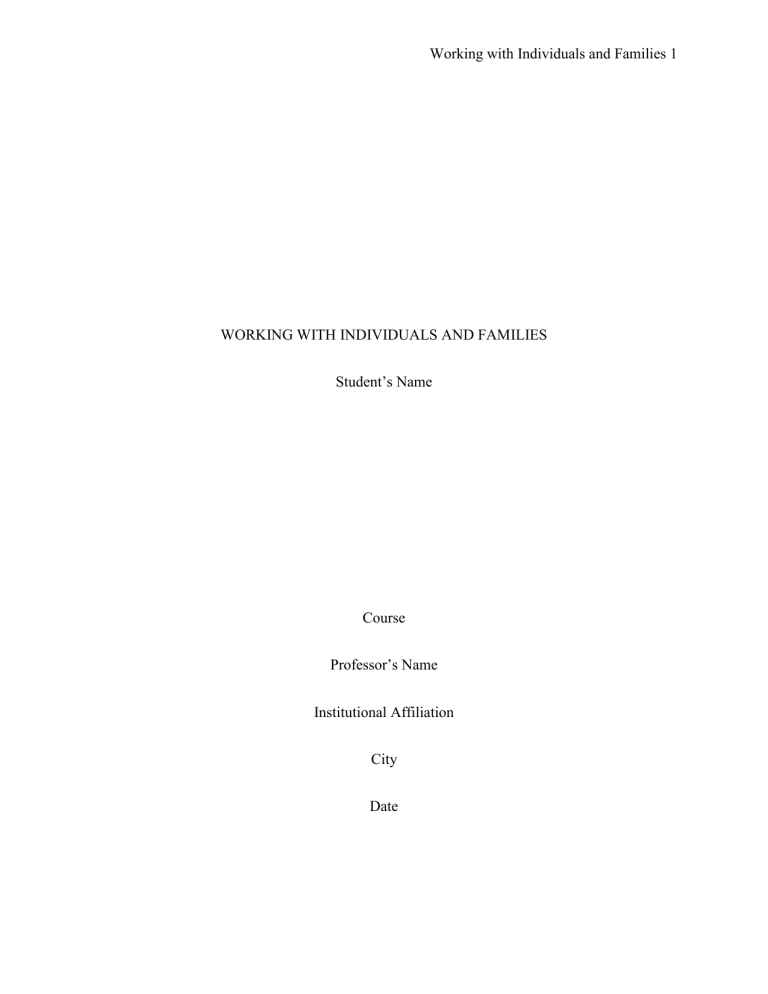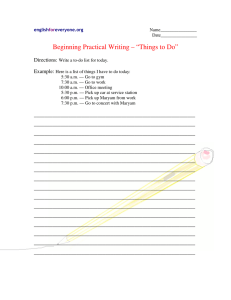
Working with Individuals and Families 1 WORKING WITH INDIVIDUALS AND FAMILIES Student’s Name Course Professor’s Name Institutional Affiliation City Date Working with Individuals and Families 2 WORKING WITH INDIVIDUALS AND FAMILIES CASE STUDY ONE: Case notes I met with Chikal face to face at our office headquarters. Chikal was appropriately dressed depending on the prevailing weather condition of the day. During the interview, Chikal’s demeanor was open and well engaged throughout the session, revealing vital details of her personal life. We met alone, and she kept good eye contact and also answered questions comprehensively. I asked Jikap the purpose of her visit and the possible assistance that she required. Chikal indicated that she is currently undergoing emotional and physical stress owing to the many responsibilities that she has to deal with as a single mother of a two-year-old son. She indicated that she is finding a challenge in meeting her routine expenses such as house rents, monthly bills, and study loans. She then inquired if possible to get someone to help her out in meeting financial obligations so that she can comfortably provide for her son. Chikal works a part-time job, which is not sufficient to meet all the financial needs. Chikal recorded to be highly stressed primarily due to her inability to pay her monthly bills with no family to help, and she does she obtain any help from the government. Based on Chikal’s description of the situation and the need to seek external help indicates her desperation. I, therefore, promised Chikal external help through various sources both financially to meet her bills and emotionally by talking to a psychologist. The current account of Chikal’s situation indicates evidence of emotional and psychological stress that a single mother can be exposed to and the associated risks. Working with Individuals and Families 3 CASE STUDY TWO: ‘at risk’ Case Study Working with Individuals and Families Cultural competence and cross-cultural awareness are a continuing process. In social work, it is always recommendable for the professionals to understand circumstances as well as the associated social issues from the perspective presented by the client. Allen (2010) defines cultural competence as a set of skills, values, and principles that help social workers to take cognizance, respect and collaborate towards realizing optimal interactions between people of different cultural and ethnic backgrounds. According to Deardorff (2011), a considerable level of competence is vital for social workers to adequately take their perspectives into account particularly in regards their cultural identity and the standpoint from which the client would view it. In general practice, the need to properly evaluate different aspects of the client’s belief systems and values as well as their personal view of themselves within their respective cultures is equally important as assessing their entire bio-psychosocial background. Ang and Van Dyne (2015) observes that developing cultural sensitivity plays a significant role in helping social workers to learn different perspectives and cultural views about particular social issues. More specifically, Garran and Werkmeister Rozas (2013) observe that they contribute to dispelling any possible generalization or myths that are circulating about a certain culture. With better insight, social workers are able to appropriately get a suitable match between the client’s needs and the offered services and available resources. Overall, social work often aims at advancing social justice, equality in the communities, and ends all sorts of discriminations. Working with Individuals and Families 4 At the heart of competency and cultural sensitivity is effective communication that often has as its basis a desirable end of establishing mutual respect and empathy. Fisher-Borne et al. (2015) observe that social work professionals are encouraged to embrace cultural diversity, which entails acknowledging and accepting the inherent differences in behavior, appearance as well as culture. For the social worker working with the Maryam and her family to become culturally competent, he or she must first attempt to be adequately aware of the specific culture in question. Garran and Werkmeister Rozas (2013) observes that taking stock of the culture, differing values, and the biases are crucial in understanding how that background affects the client’s view and perspective of others. According to Deardorff (2011), assessing one’s prejudices and preconceptions is the most critical steps towards becoming cultural competent social workers. The second step is seeking knowledge, particularly about the other cultures and ensuring the striking differences are marked and similarities noted. Ang and Van Dyne (2015) observe that without adequate knowledge about the culture in question, even the best intentions are to be seen as offensive to other people. Working with the Maryam and her family requires an adequate understanding of the situation and the factors leading to the condition of the client. Although she has a different ethnic background, Maryam has made significant and quite remarkable progress in her academic work and even in her social life. However, her situation at home required careful handling with considerable sensitivity to the cultural conflicts that her parents were experiencing. For a social worker, adopting an open channel of communication with each party would help them have a change of attitude and tendencies towards other cultures. Through positive communication, the professional would be able to resolve some of the issues in the relationship, and this will result in making a positive change for all the family members. Thus, they will develop the ability to Working with Individuals and Families 5 approach issues with more open minds without the cultural limitations that restricts one’s perspectives from appreciating the enriching diversity of the people around. As a student, I would also embrace open communication and encourage a positive outlook of the inherent differences in cross-cultures. CASE STUDY THREE: Professional Self-Care Stresses of a Professional Social Worker Social work is primarily client-based, thereby exposing the professionals to various complex situations when dealing with customers who have varied social and psychological problems (Maslach and Jackson 2013). As such, social workers experience a great deal of conflicts in the course of their duties, and these result in various forms of work-related stresses that affect their mode of operations. Some of the common types of stress that these individuals experience include physical stress that relates to the actual activities and events that wreak havoc to the normal function of a human body and it usually occurs due to the long working hours with the patients. The other form is emotional stress that occurs when these individuals undergo depressions when overwhelmed at work due to exposure to clients facing different problems (Beehr 2014). The last form of stress that social workers face is the acute stress that is primarily caused by the social working environment of these professionals, which involves dealing with difficult individuals and families. Strategies for Dealing with Stress as a Social Worker As noted by Lloyd, King, and Chenoweth (2002), the effects of stress can accumulate over time as an individual is continuously exposed to the stressors. Some of the vital strategies that are essential in stress management include meditation, professional counselling, problem- Working with Individuals and Families 6 solving on major issues, and altering some irrational beliefs (Thoits 2011). Emotional eating and prescribed drugs are also essential mechanisms for coping with stress in the context of the agency. As an individual, some of the ways of managing stress include taking care of personal health, regular relaxation through sufficient sleep, dedicating enough time for oneself regularly (Ganster and Rosen 2013). Hypothetical Self-Care Plan for a Professional Worker As a professional social worker, a self-care plan is essential in enhancing my personal health and wellbeing, improve my professional productivity and efficiency, and also effectively manage stress when working with individuals and families. My self-care will entail professional care, physical care, psychological and emotional care (Maslach and Jackson 2013). In professional care, I will set-up a peer-support group and read professional journals to enhance my skills. For physical care, will develop a regular sleep routine and adopt a healthy diet, and for psychological and emotional care, I will adopt a non-work hobby to relax my mind (Lee and Miller 2013). Working with Individuals and Families 7 References Allen, J., 2010. Improving cross-cultural care and antiracism in nursing education: A literature review. Nurse Education Today, 30(4), pp.314-320. Ang, S. and Van Dyne, L., 2015. Handbook of cultural intelligence. Routledge. Deardorff, D.K., 2011. Assessing intercultural competence. New directions for institutional research, 2011(149), p.65. Beehr, T.A., 2014. Psychological stress in the workplace (psychology revivals). Routledge. Fisher-Borne, M., Cain, J.M. and Martin, S.L., 2015. From mastery to accountability: Cultural humility as an alternative to cultural competence. Social Work Education, 34(2), pp.165181. Ganster, D.C. and Rosen, C.C., 2013. Work stress and employee health: A multidisciplinary review. Journal of management, 39(5), pp.1085-1122. Garran, A.M. and Werkmeister Rozas, L., 2013. Cultural competence revisited. Journal of Ethnic and Cultural Diversity in Social Work, 22(2), pp.97-111. Lee, J.J. and Miller, S.E., 2013. A self-care framework for social workers: Building a strong foundation for practice. Families in Society, 94(2), pp.96-103. Lloyd, C., King, R. and Chenoweth, L., 2002. Social work, stress and burnout: A review. Journal of mental health, 11(3), pp.255-265. Maslach, C. and Jackson, S.E., 2013. A social psychological analysis. Social psychology of health and illness, 227. Thoits, P.A., 2011. Mechanisms linking social ties and support to physical and mental health. Journal of health and social behavior, 52(2), pp.145-161.


